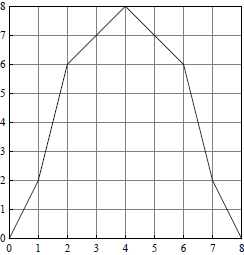Homework 6
Due Date: Friday, October 30
Let \(f\colon[0,8]\to[0,8]\) be the following piecewise-linear function.
 \(\displaystyle f(x)\;=\;\begin{cases}
2x & \text{if }0 \leq x < 1, \\[6pt]
4x - 2 & \text{if }1 \leq x < 2, \\[6pt]
x+4 & \text{if }2 \leq x < 4, \\[6pt]
12 - x & \text{if }4 \leq x < 6, \\[6pt]
30-4x & \text{if }6 \leq x < 7, \\[6pt]
16-2x & \text{if }7 \leq x \leq 8.
\end{cases}\)
\(\displaystyle f(x)\;=\;\begin{cases}
2x & \text{if }0 \leq x < 1, \\[6pt]
4x - 2 & \text{if }1 \leq x < 2, \\[6pt]
x+4 & \text{if }2 \leq x < 4, \\[6pt]
12 - x & \text{if }4 \leq x < 6, \\[6pt]
30-4x & \text{if }6 \leq x < 7, \\[6pt]
16-2x & \text{if }7 \leq x \leq 8.
\end{cases}\)
As with the tent map, we can make itineraries for \(f\), with \(\mathsf{L}=[0,4]\) and \(\mathsf{R}=[4,8]\). The goal of this assignment is to show that \(f\) is topologically conjugate to the tent map.
-
- The function \(f\) has one fixed point on the interval \((0,8)\). Find it.
- Find the point whose itinerary under \(f\) is \(\mathsf{LRRRRRR}\cdots\).
- What are the corresponding points for the tent map?
- Find the endpoints of the \(\mathsf{LL}\), \(\mathsf{LR}\), \(\mathsf{RR}\), and \(\mathsf{RL}\) intervals for \(f\). Do the same for the \(\mathsf{LLL}\), \(\mathsf{LLR}\), \(\mathsf{LRR}\), \(\mathsf{LRL}\), \(\mathsf{RRL}\), \(\mathsf{RRR}\), \(\mathsf{RLR}\), and \(\mathsf{RLL}\) intervals.
- Find the itinerary of the point \(1.6\) under \(f\).
- Find the Lyapunov number of the periodic cycle you found in part (a)
- Which point in \([0,1]\) has the same itinerary under the tent map?
-
- The function \(f\) has two \(3\)-cycles. Find them. (Express your answers as fractions.)
- Determine the Lyapunov numbers of the cycles that you found in part (a).
- Find the two \(3\)-cycles for the tent map.
- To show that the dynamical systems determined by \(f\) and \(T\) are topologically conjugate, we must find a homeomorphism \(c\colon[0,1]\to[0,8]\) such that \(c\circ T = f\circ c\).
- Use questions 1–4 to list twenty-one data points for the function \(c\) (two from question 1, nine from question 2, four from question 3, and six from question 4).
- Find the formula for a function \(c\) whose graph includes all \(21\) data points. Verify this by plotting a graph of \(c\) together with the data points.
- Use Mathematica to verify that your formula for \(c\) satisfies \(c\circ T = f\circ c\).